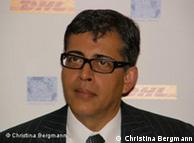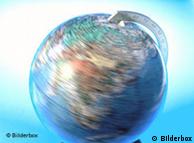GLOBALIZATION | 14.11.2011
Study highlights untapped potential of globalization
Globalization is not as advanced as most people believe. That's according to the first Global Connectedness Index (GCI), commissioned by German-based global logistics group DHL.
The study, conducted by renowned economist Pankaj Ghemawat from the IESE Business School in Barcelona, analyzed flows of information, capital and people on a detailed country-by-country basis.
It found that further economic integration could still generate global gross domestic product gains of 5 percent or more – the equivalent of trillions of euros.
"Only two percent of all telephone calls are made internationally, while just 10 percent of investments are made across borders," Ghemawat said, adding that the world was currently only exploiting between 10 and 20 percent of its "globalization potential."
Dimensions of integration
 Professor Pankaj Ghemawat conducted the study for logistics giant DHLThe GCI report evaluated both the depth and geographicbreadth of 125 nations' links to other countries.
Professor Pankaj Ghemawat conducted the study for logistics giant DHLThe GCI report evaluated both the depth and geographicbreadth of 125 nations' links to other countries.Depth refers to the size of a country's international flows as compared to a relevant measure of the size of its domestic economy. In other words: how important interactions with the rest of the world are in to business and life in a particular country. Countries with leading positions in terms of depth tend to be wealthy and small.
Breadth, on the other hand, measures how closely a country's distribution of international flows across its partner countries matches the global distribution of the same type of flows. Countries with high breadth ratings tend to be wealthy and relatively large, enabling them to maintain ties with a wide range of markets instead of focusing heavily on a small number of traditional partners.
Netherlands first, Nepal last
The Netherlands was rated number one in the Global Connectedness Index, followed by Singapore and Ireland.
As a former sea power, the Netherlands has a long history of international trade and interaction with the New World. The cultural legacy of that tradition, combined with its current heavy involvement in the European Union, makes it roughly 140 times more interconnected than Nepal, which received the worst rating in the GCI.
Nepal's lack of links with the outside world can be explained partly by its geographic location in the Himalaya Mountains, where problems with accessibility have contributed to a lack of cooperation among neighboring states.
 Technology has enabled increased flows of informationBut financial and economic policies play a role too. It is no coincidence that Nepal only ranked 118th in the 2010 Enabling Trade Index compiled by the World Economic Forum, which measured 125 countries according to their market accessibility, border controls, infrastructure and policy environments.
Technology has enabled increased flows of informationBut financial and economic policies play a role too. It is no coincidence that Nepal only ranked 118th in the 2010 Enabling Trade Index compiled by the World Economic Forum, which measured 125 countries according to their market accessibility, border controls, infrastructure and policy environments.Ghemawat said sensible trade and financial policies promote interconnectedness, which in turn promotes economic growth. He warned governments against pursuing isolationist policies aimed at protecting jobs and domestic industry. "That's how you end up in a downward spiral, like in the 1930s," he said.
German gains
Germany was ranked 13th in the GCI after its interconnectedness metrics improved across the board between 2005 and 2010. Ghemawat attributed these gains to the breadth of Germany's links to wide range of trade partners. This diverse network helped the nation compensate for recent economic downturns in the United States and Europe by making gains in emerging markets.
While most German trade is still concentrated within the European Union, Ghemawat said there were still plenty of opportunities for Germany to improve its links with the East. He pointed out that most international telephone calls made from Germany connected with Turkey.
"There are big chances there," he told Deutsche Welle, adding that Turkey could emerge as the gateway to booming Asian markets.
Author: Christina Bergmann, Sam Edmonds
Editor: Andreas Illmer
Editor: Andreas Illmer
dw


No comments:
Post a Comment